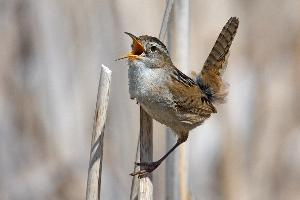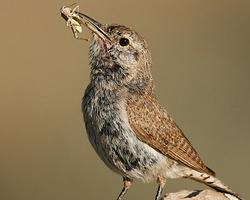
Állatleírás
The Marsh Wren (Cistothorus palustris) is a small, enchanting songbird that graces the freshwater and brackish marshes of North America with its presence. This diminutive bird, often no larger than 4 to 5 inches in length, boasts a remarkably loud voice and an intricate nest-building ability, making it a fascinating subject of study and observation in its natural habitat.Physically, the Marsh Wren exhibits a rather nondescript, yet charming, appearance. Its plumage is predominantly brown and heavily streaked with black, enabling it to blend seamlessly into the reeds and cattails of its marshy home. The bird's underparts are a lighter brown, sometimes with a hint of gray or white, which contrasts subtly with its darker, barred wings and tail. A distinguishing feature of the Marsh Wren is its white eyebrow stripe, which stands out against its brown head, along with a short, stubby bill perfectly adapted for its insectivorous diet.
One of the most notable behaviors of the Marsh Wren is its singing. Males are particularly vocal, especially during the breeding season when they emit a series of complex and melodious trills, buzzes, and chatters. These vocalizations serve multiple purposes, including the attraction of mates and the establishment of territorial boundaries. Each male can produce hundreds of unique song variations, showcasing an impressive vocal repertoire.
The nesting habits of the Marsh Wren are equally intriguing. Males are polygamous, often mating with several females within their territory. They take the lead in constructing multiple globe-shaped nests attached to reeds or cattails above the water. These structures are intricately woven from strips of plant material and lined with softer materials for insulation. Interestingly, males build several "dummy" nests within their territory, which are thought to play a role in attracting females and possibly in deterring predators.
Marsh Wrens are primarily insectivorous, feeding on a variety of insects and spiders found within their marshy environment. Their diet plays a crucial role in controlling insect populations, highlighting their importance in the ecosystem. They forage among the dense vegetation, adeptly maneuvering through the reeds to capture their prey.
The breeding range of the Marsh Wren spans across much of Canada and the United States, with many populations migrating to the southern United States and Mexico for the winter. Despite facing threats such as habitat destruction and pollution, the Marsh Wren has managed to maintain relatively stable population levels in areas where wetlands are preserved.
In conclusion, the Marsh Wren is a remarkable bird species that embodies the beauty and complexity of North American marshlands. Its distinctive song, intricate nesting behavior, and role in the ecosystem make it a vital and captivating part of its habitat. Conservation efforts to protect wetland areas not only benefit the Marsh Wren but also support the myriad of other species that rely on these critical environments for survival.
Hasonló állatok
Új állatfotók
Top 10 állat
- Diana monkey (Cercopithecus diana)
- Dolphin gull (Leucophaeus scoresbii)
- Moustached guenon (Cercopithecus cephus)
- Galápagos tortoise (Geochelone nigra complex)
- Stone loach (Barbatula barbatula)
- Japanese spider crab (Macrocheira kaempferi)
- Colossal squid (Mesonychoteuthis hamiltoni)
- Common house mosquito (Culex pipiens)
- Common reed warbler (Acrocephalus scirpaceus)
- Sea urchins (Echinoidea)

